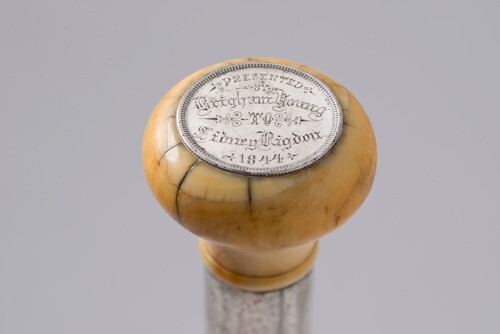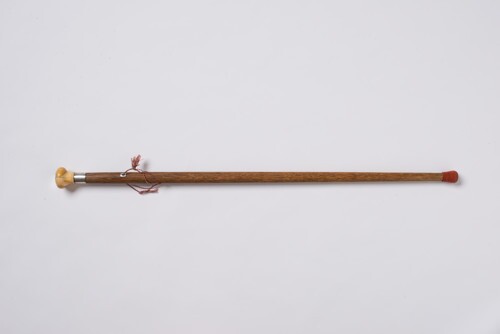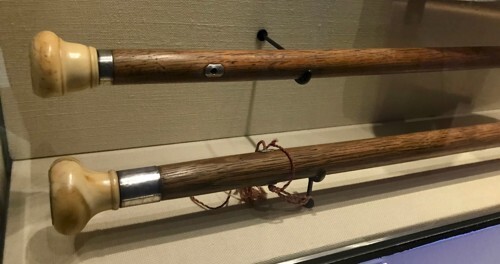Editor's note: This article was originally published in 2019.
After a mob rushed the Carthage Jail and killed Joseph and Hyrum Smith in 1844, the martyrs' bodies were transported back to Nauvoo, Illinois, in a pair of rough-hewn oak coffins.
A short time later, pieces of the oak planks were used to make canes, with some containing locks of the brothers' hair in the ivory knob, as special mementos and sacred relics for some of the Prophet's closest friends, including Willard Richards, Heber C. Kimball, Dimick Huntington, Wilford Woodruff and Brigham Young.

The knob on this coffin cane bears the inscription: "Presented by Brigham Young to Sidney Rigdon, 1844." It is one of two coffin canes on display at the Church History Museum. Welden C. Andersen/The Church of Jesus Christ of Latter-day Saints.
What little is known about these "Canes of the Martyrdom" was compiled and published by a Brigham Young University history student named Steven G. Barnett in 1981.
"The Canes of the Martyrdom are a very real part of the Mormon heritage," Barnett wrote. "Shrouded in mystery as they are, the canes stand as a testimony of the love the owners shared for the Prophet Joseph Smith and his work."
This June 27 marks the 175th anniversary of the martyrdom.

The Church of Jesus Christ of Latter-day Saints has two oak canes made by Brigham Young from the coffin in which the body of Joseph Smith was carried from Carthage to Nauvoo, Illinois, after the martyrdom on June 27, 1844. Welden C. Andersen/The Church of Jesus Christ of Latter-day Saints.
Barnett's four-page history features several references to the canes in Latter-day Saint literature.
One comes from the "Life of Heber C. Kimball," by Orson F. Whitney.
"How much would you give for even a cane that Father Abraham had used, or a coat or ring that the Savior had worn? The rough oak boxes in which the bodies of Joseph and Hyrum were brought from Carthage, were made into canes and other articles," Whitney wrote. "I have a cane made from the plank of one of those boxes, so has Brother Brigham and a great many others, and we prize them highly and esteem them a great blessing."
In a journal entry dated Aug. 23, 1844, Woodruff writes about visiting Emma Smith and her letting him have a piece of oak for "a staff" taken from the coffin of the Prophet Joseph. She also let him have a pair of gloves and a cotton handkerchief which he used. He also visited Mary Fielding Smith, Hyrum's wife, who gave him hair from Joseph, Hyrum, Samuel Smith, and Don Carlos Smith.
"My object was in putting a portion of each in the top of my staff as a relic of those noble men, master spirits of the nineteenth century, to hand down to my posterity," Woodruff wrote.
Some of these canes are still around today.
The Church of Jesus Christ of Latter-day Saints has two "coffin canes," both of which are on display near Joseph and Hyrum's death masks in "The Heavens Are Open" exhibit at the Church History Museum.

This photo shows the two coffin canes on display in the Church History Museum.Trent Toone/Deseret News
One, presented to President Joseph F. Smith in 1905, bears the inscription: "Presented by Brigham Young to Sidney Rigdon, 1844."
Huntington was the original owner of the second cane, which was donated in the name of George Joseph Huntington.
The Daughters of Utah Pioneers also have two canes in its collection at the Pioneer Memorial Museum. Both canes have ivory handles, although one has hair in the knob and the other does not. The cane without hair is on the first floor in case 67. The cane with hair is on the third floor, in case 2, DUP officials said.

The black cane with the ivory knob in the middle of this collection is on display at the Daughters of Utah Pioneers Museum. It is identified as a "coffin cane" and is said to have locks of hair that belonged to Joseph and Hyrum Smith. Source: exploringmormonism.com
Other coffin canes exist in private hands, according to Reid Moon, owner of Moon's Rare Books and a collector of early Latter-day Saint artifacts.
In his dealings and speaking to hundreds of groups over the last 20 years, Moon estimated that more than 99 percent of his audiences have never heard of the coffin canes.
"I became fascinated by these 'coffin canes' after I first read about their existence in a sermon given by Heber C. Kimball in the Salt Lake Tabernacle in 1857," Moon said. "As someone who collects early church artifacts, I put these few lost 'canes of the martyrdom' right up there with the Holy Grail."


